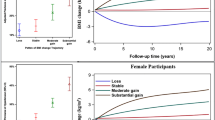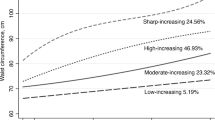Abstract
This study aimed to identify heterogeneity in BMI trajectories and evaluate the impact of BMI trajectories on the risk of hypertension in middle-aged and elderly Chinese people. After data screening, 28, 706 residents’ e-health records from 2010 to 2018, including basic personal information, lifestyle and health, were finally included in this population-based longitudinal study. By latent class growth modeling, we identified 12 BMI trajectories: “underweight—increase I (A1)” and “underweight—increase II (A2)”; “normal weight—stable (B1)”, “normal weight—decrease (B2)”, “normal weight—increase I (B3)” and “normal weight—increase II (B4)”; “overweight—stable (C1)”, “overweight—decrease (C2)” and “overweight—increase (C3)”; and “obese—stable I (D1)”, “obese—decrease (D2)” and “obese—stable II (D3)”. By Cox proportional hazards models, we found that the risk of hypertension in the BMI stable group was lower than that in the BMI increasing trajectory group and higher than that in the BMI decreasing group. For the underweight and normal weight groups, the risk of hypertension was related not only to the magnitude of BMI growth, but also to the rate of growth. For overweight and obesity groups, the risk of hypertension was higher in the high-level stable BMI group than in the low-level stable BMI group. Therefore, for underweight and normal weight people, weight growth and growth rate should be controlled; for overweight and obese people, health education or targeted weight loss exercise should be taken to reduce weight as much as possible to prevent hypertension.
This is a preview of subscription content, access via your institution
Access options
Subscribe to this journal
Receive 12 digital issues and online access to articles
$119.00 per year
only $9.92 per issue
Buy this article
- Purchase on Springer Link
- Instant access to full article PDF
Prices may be subject to local taxes which are calculated during checkout


Similar content being viewed by others
Code availability
The core code example of SAS to fit LCGM in this study are as follows:
PROC TRAJ DATA = OPOPOSITN OUTPLOT = OP OUTSTAT = OS OUT = OUTEST = OE
ITDETAIL; ID ID; VAR BMI2010-BMI2018; INDEP T2011-T2018;
MODEL CNORM; MAX 45; NGROUPS 3; ORDER 3 3 3;
RUN;
For more information about LCGM, please refer to the website: http://www.andrew.cmu.edu/user/bjones/.
References
Wang M, Yi Y, Roebothan B, Colbourne J, Maddalena V, Sun G, et al. Trajectories of body mass index among Canadian seniors and associated mortality risk. BMC Public Health. 2017;17:929.
Tibazarwa KB, Damasceno AA. Hypertension in developing countries. Can J Cardiol. 2014;30:527–33.
Yang G, Wang Y, Zeng Y, Gao GF, Liang X, Zhou M, et al. Rapid health transition in China, 1990–2010: findings from the Global Burden of Disease Study 2010. Lancet 2013;381:1987–2015.
Chen PC, Sung FC, Su TC, Chien KL, Hsu HC, Lee YT. Two-year change in body mass index and subsequent risk of hypertension among men and women in a Taiwan community. J Hypertens. 2009;27:1370–6.
Decoda Study G, Nyamdorj R, Qiao Q, Lam TH, Tuomilehto J, Ho SY, et al. BMI compared with central obesity indicators in relation to diabetes and hypertension in Asians. Obesity. 2008;16:1622–35.
Droyvold WB, Midthjell K, Nilsen TI, Holmen J. Change in body mass index and its impact on blood pressure: a prospective population study. Int J Obes. 2005;29:650–5.
Katz EG, Stevens J, Truesdale KP, Cai J, North KE, Steffen LM. Associations of body mass index with incident hypertension in American white, American black and Chinese Asian adults in early and middle adulthood: the Coronary Artery Risk Development in Young Adults (CARDIA) study, the Atherosclerosis Risk in Communities (ARIC) study and the People’s Republic of China (PRC) study. Asia Pac J Clin Nutr. 2013;22:626–34.
Stevens J, Truesdale KP, Katz EG, Cai J. Impact of body mass index on incident hypertension and diabetes in Chinese Asians, American Whites, and American Blacks: the People’s Republic of China Study and the Atherosclerosis Risk in Communities Study. Am J Epidemiol. 2008;167:1365–74.
Muthen B, Brown CH, Masyn K, Jo B, Khoo ST, Yang CC, et al. General growth mixture modeling for randomized preventive interventions. Biostatistics. 2002;3:459–75.
Nagin DS, Odgers CL. Group-based trajectory modeling in clinical research. Annu Rev Clin Psychol. 2010;6:109–38.
Botoseneanu A, Liang J. Latent heterogeneity in long-term trajectories of body mass index in older adults. J Aging Health. 2013;25:342–63.
Paynter L, Koehler E, Howard AG, Herring AH, Gordon-Larsen P. Characterizing long-term patterns of weight change in China using latent class trajectory modeling. PLoS ONE. 2015;10:e0116190.
Ng C, Corey PN, Young TK. Divergent body mass index trajectories between Aboriginal and non-Aboriginal Canadians 1994-2009-an exploration of age, period, and cohort effects. Am J Hum Biol. 2012;24:170–6.
Setia MS, Quesnel-Vallee A, Abrahamowicz M, Tousignant P, Lynch J. Convergence of body mass index of immigrants to the Canadian-born population: evidence from the National Population Health Survey (1994-2006). Eur J Epidemiol. 2009;24:611–23.
Sherar LB, Eisenmann JC, Chilibeck PD, Muhajarine N, Martin S, Bailey DA, et al. Relationship between trajectories of trunk fat mass development in adolescence and cardiometabolic risk in young adulthood. Obesity. 2011;19:1699–706.
Abarin T, Yan WuY, Warrington N, Lye S, Pennell C, Briollais L. The impact of breastfeeding on FTO-related BMI growth trajectories: an application to the Raine pregnancy cohort study. Int J Epidemiol. 2012;41:1650–60.
Wen X, Kleinman K, Gillman MW, Rifas-Shiman SL, Taveras EM. Childhood body mass index trajectories: modeling, characterizing, pairwise correlations and socio-demographic predictors of trajectory characteristics. BMC Med Res Methodol. 2012;12:38.
Lewington S, Lacey B, Clarke R, Guo Y, Kong XL, Yang L, et al. The burden of hypertension and associated risk for cardiovascular mortality in China. JAMA Intern Med. 2016;176:524–32.
Gao Y, Chen G, Tian H, Lin L, Lu J, Weng J, et al. Prevalence of hypertension in china: a cross-sectional study. PLoS ONE. 2013;8:e65938.
Kuchibhatla MN, Fillenbaum GG, Kraus WE, Cohen HJ, Blazer DG. Trajectory classes of body mass index in a representative elderly community sample. J Gerontol A Biol Sci Med Sci. 2013;68:699–704.
Tu AW, Masse LC, Lear SA, Gotay CC, Richardson CG. Body mass index trajectories from ages 1 to 20: results from two nationally representative canadian longitudinal cohorts. Obesity. 2015;23:1703–11.
Wang M, Yi Y, Roebothan B, Colbourne J, Maddalena V, Wang PP, et al. Body mass index trajectories among middle-aged and elderly Canadians and associated health outcomes. J Environ Public Health. 2016;2016:7014857.
Buscot MJ, Thomson RJ, Juonala M, Sabin MA, Burgner DP, Lehtimaki T, et al. Distinct child-to-adult body mass index trajectories are associated with different levels of adult cardiometabolic risk. Eur Heart J. 2018;39:2263–70.
Heianza Y, Arase Y, Kodama S, Tsuji H, Tanaka S, Saito K, et al. Trajectory of body mass index before the development of type 2 diabetes in Japanese men: Toranomon Hospital Health Management Center Study 15. J Diabetes Investig. 2015;6:289–94.
Fan B, Yang Y, Dayimu A, Zhou G, Liu Y, Li S, et al. Body mass index trajectories during young adulthood and incident hypertension: a longitudinal cohort in Chinese population. J Am Heart Assoc. 2019;8:e011937.
Chobanian AV, Bakris GL, Black HR, Cushman WC, Green LA, Izzo JL Jr., et al. Seventh report of the Joint National Committee on Prevention, Detection, Evaluation, and Treatment of High Blood Pressure. Hypertension. 2003;42:1206–52.
Tsujimoto T, Sairenchi T, Iso H, Irie F, Yamagishi K, Tanaka K, et al. Impact of obesity on incident hypertension independent of weight gain among nonhypertensive Japanese: the Ibaraki Prefectural Health Study (IPHS). J Hypertens. 2012;30:1122–8.
Neter JE, Stam BE, Kok FJ, Grobbee DE, Geleijnse JM. Influence of weight reduction on blood pressure: a meta-analysis of randomized controlled trials. Hypertension. 2003;42:878–84.
Ren Q, Su C, Wang H, Wang Z, Du W, Zhang B. Change in body mass index and its impact on incidence of hypertension in 18–65-year-old Chinese adults. Int J Environ Res Public Health. 2016;13:257.
Luo W, Chen F, Guo Z, Wu M, Hao C, Zhou Z, et al. Comparison of the suitability of 2 years change in waist circumference and body mass index in predicting hypertension risk: a prospective study in Chinese-Han. Iran J Public Health. 2014;43:1212–20.
Li W, Wang D, Wu C, Shi O, Zhou Y, Lu Z. The effect of body mass index and physical activity on hypertension among Chinese middle-aged and older population. Sci Rep. 2017;7:10256.
Shihab HM, Meoni LA, Chu AY, Wang NY, Ford DE, Liang KY, et al. Body mass index and risk of incident hypertension over the life course: the Johns Hopkins Precursors Study. Circulation. 2012;126:2983–9.
Zhang M, Zhao Y, Sun H, Luo X, Wang C, Li L, et al. Effect of dynamic change in body mass index on the risk of hypertension: Results from the Rural Chinese Cohort Study. Int J Cardiol. 2017;238:117–22.
Xie YJ, Ho SC, Su X, Liu ZM. Changes in body weight from young adulthood to middle age and its association with blood pressure and hypertension: a cross-sectional study in Hong Kong Chinese Women. J Am Heart Assoc. 2016;5:e002361.
Bui DS, Lodge CJ, Burgess JA, Lowe AJ, Perret J, Bui MQ, et al. Childhood predictors of lung function trajectories and future COPD risk: a prospective cohort study from the first to the sixth decade of life. Lancet Respir Med. 2018;6:535–44.
Ackrivo J, Hansen-Flaschen J, Jones BL, Wileyto EP, Schwab RJ, Elman L, et al. Classifying patients with amyotrophic lateral sclerosis by changes in FVC. A group-based trajectory analysis. Am J Respir Crit Care Med. 2019;200:1513–21.
Mazzali C, Duca P. Use of administrative data in healthcare research. Intern Emerg Med. 2015;10:517–24.
Gavrielov-Yusim N, Friger M. Use of administrative medical databases in population-based research. J Epidemiol Community Health. 2014;68:283–7.
van Walraven C, Austin P. Administrative database research has unique characteristics that can risk biased results. J Clin Epidemiol. 2012;65:126–31.
Acknowledgements
The authors thank all of the individuals, investigators, and administrators for their support and help during the research. We are also grateful to Yujing Zhang for their insightful comments that greatly improved the paper.
Funding
This research was funded by the National Key Research and Development Program of China (2017YFC1307705 and 2016YFC0106907), the Science and Technology Development Program of Henan (201403007), the Science and Technology Development Program of Zhengzhou (141PPTGG441), and the Key Science and Technology Research of Henan Department of Education (14A330009).
Author information
Authors and Affiliations
Corresponding author
Ethics declarations
Conflict of interest
The authors declare that they have no conflict of interest.
Additional information
Publisher’s note Springer Nature remains neutral with regard to jurisdictional claims in published maps and institutional affiliations.
Rights and permissions
About this article
Cite this article
Guo, B., Shi, Z., Zhang, W. et al. Trajectories of body mass index (BMI) and hypertension risk among middle-aged and elderly Chinese people. J Hum Hypertens 35, 537–545 (2021). https://doi.org/10.1038/s41371-020-0368-7
Received:
Revised:
Accepted:
Published:
Issue Date:
DOI: https://doi.org/10.1038/s41371-020-0368-7



